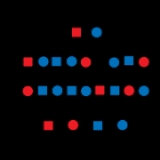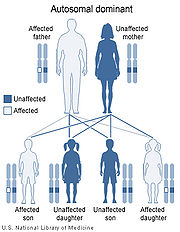
Rubinstein-Taybi syndrome
Encyclopedia
Rubinstein-Taybi Syndrome (RTS), also known as broad thumb-hallux syndrome or Rubinstein syndrome, is a condition
characterized by short stature, moderate to severe learning difficulties, distinctive facial features, and broad thumbs and first toes. Other features of the disorder vary among affected individuals. People with this condition have an increased risk of developing noncancerous and cancerous tumors, leukemia
, and lymphoma
. This condition is inherited in an autosomal dominant pattern and is uncommon, occurring in an estimated 1 in 125,000 births.
Typical features of the disorder include:
A 2009 study found that children with RTS were more likely to be overweight and to have a short attention span, motor stereotypies, and poor coordination, and hypothesized that the identified CREBBP gene impaired motor skills learning.
 Mutation
Mutation
s in the CREBBP gene
cause Rubinstein–Taybi syndrome. The CREBBP gene makes a protein that helps control the activity of many other genes. The protein, called CREB-binding protein, plays an important role in regulating cell growth
and division
and is essential for normal fetal development
. If one copy of the CREBBP gene is deleted or mutated, cells make only half of the normal amount of CREB binding protein. A reduction in the amount of this protein disrupts normal development before and after birth, leading to the signs and symptoms of Rubinstein–Taybi syndrome.
Mutations in the EP300
gene are responsible for a small percentage of cases of Rubinstein–Taybi syndrome. These mutations result in the loss of one copy of the gene in each cell, which reduces the amount of p300 protein by half. Some mutations lead to the production of a very short, nonfunctional version of the p300 protein, while others prevent one copy of the gene from making any protein at all. Although researchers do not know how a reduction in the amount of p300 protein leads to the specific features of Rubinstein–Taybi syndrome, it is clear that the loss of one copy of the EP300 gene disrupts normal development.
1 out of 100.000 to 125.000 children are born with RTS
Syndrome
In medicine and psychology, a syndrome is the association of several clinically recognizable features, signs , symptoms , phenomena or characteristics that often occur together, so that the presence of one or more features alerts the physician to the possible presence of the others...
characterized by short stature, moderate to severe learning difficulties, distinctive facial features, and broad thumbs and first toes. Other features of the disorder vary among affected individuals. People with this condition have an increased risk of developing noncancerous and cancerous tumors, leukemia
Leukemia
Leukemia or leukaemia is a type of cancer of the blood or bone marrow characterized by an abnormal increase of immature white blood cells called "blasts". Leukemia is a broad term covering a spectrum of diseases...
, and lymphoma
Lymphoma
Lymphoma is a cancer in the lymphatic cells of the immune system. Typically, lymphomas present as a solid tumor of lymphoid cells. Treatment might involve chemotherapy and in some cases radiotherapy and/or bone marrow transplantation, and can be curable depending on the histology, type, and stage...
. This condition is inherited in an autosomal dominant pattern and is uncommon, occurring in an estimated 1 in 125,000 births.
Features of Rubinstein-Taybi syndrome
A case was described in 1957 by Michail, Matsoukas and Theodorou. In 1963 Jack Herbert Rubinstein and Hooshang Taybi described a larger series of cases.Typical features of the disorder include:
- Broad thumbs and broad first toes
- Mental disability
- Small height, bone growth, small head
- CryptorchidismCryptorchidismCryptorchidism is the absence of one or both testes from the scrotum. It is the most common birth defect regarding male genitalia. In unique cases, cryptorchidism can develop later in life, often as late as young adulthood. About 3% of full-term and 30% of premature infant boys are born with at...
in males - Unusual faces involving the eyes, nose, and palatePalateThe palate is the roof of the mouth in humans and other mammals. It separates the oral cavity from the nasal cavity. A similar structure is found in crocodilians, but, in most other tetrapods, the oral and nasal cavities are not truly separate. The palate is divided into two parts, the anterior...
A 2009 study found that children with RTS were more likely to be overweight and to have a short attention span, motor stereotypies, and poor coordination, and hypothesized that the identified CREBBP gene impaired motor skills learning.
Genetics

Mutation
In molecular biology and genetics, mutations are changes in a genomic sequence: the DNA sequence of a cell's genome or the DNA or RNA sequence of a virus. They can be defined as sudden and spontaneous changes in the cell. Mutations are caused by radiation, viruses, transposons and mutagenic...
s in the CREBBP gene
Gene
A gene is a molecular unit of heredity of a living organism. It is a name given to some stretches of DNA and RNA that code for a type of protein or for an RNA chain that has a function in the organism. Living beings depend on genes, as they specify all proteins and functional RNA chains...
cause Rubinstein–Taybi syndrome. The CREBBP gene makes a protein that helps control the activity of many other genes. The protein, called CREB-binding protein, plays an important role in regulating cell growth
Cell growth
The term cell growth is used in the contexts of cell development and cell division . When used in the context of cell division, it refers to growth of cell populations, where one cell grows and divides to produce two "daughter cells"...
and division
Cell division
Cell division is the process by which a parent cell divides into two or more daughter cells . Cell division is usually a small segment of a larger cell cycle. This type of cell division in eukaryotes is known as mitosis, and leaves the daughter cell capable of dividing again. The corresponding sort...
and is essential for normal fetal development
Fetal development
Prenatal or antenatal development is the process in which a human embryo or fetus gestates during pregnancy, from fertilization until birth. Often, the terms fetal development, foetal development, or embryology are used in a similar sense.After fertilization the embryogenesis starts...
. If one copy of the CREBBP gene is deleted or mutated, cells make only half of the normal amount of CREB binding protein. A reduction in the amount of this protein disrupts normal development before and after birth, leading to the signs and symptoms of Rubinstein–Taybi syndrome.
Mutations in the EP300
EP300
E1A binding protein p300 also known as EP300 or p300 is a protein that, in humans, is encoded by the EP300 gene. This protein regulates the activity of many genes in tissues throughout the body...
gene are responsible for a small percentage of cases of Rubinstein–Taybi syndrome. These mutations result in the loss of one copy of the gene in each cell, which reduces the amount of p300 protein by half. Some mutations lead to the production of a very short, nonfunctional version of the p300 protein, while others prevent one copy of the gene from making any protein at all. Although researchers do not know how a reduction in the amount of p300 protein leads to the specific features of Rubinstein–Taybi syndrome, it is clear that the loss of one copy of the EP300 gene disrupts normal development.
1 out of 100.000 to 125.000 children are born with RTS
External links
- RTS - Rubinstein-Taybi Syndrome - Associazione italiana RTS
- RTS - Rubinstein-Taybi Syndrome - A site devoted to the families and people diagnosed with Rubinstein-Taybi Syndrome.
- RTS - Rubinstein-Taybi Syndrome Argentina - RTS Argentina - www.rubinsteintaybi.com.ar - Grupo de Apoyo - Historias.-
- Dutch RTS-site - RTS the Netherlands
- History of RTS by J.H. Rubinstein.
- GeneReview/UW/NIH entry on Rubinstein-Taybi syndrome

